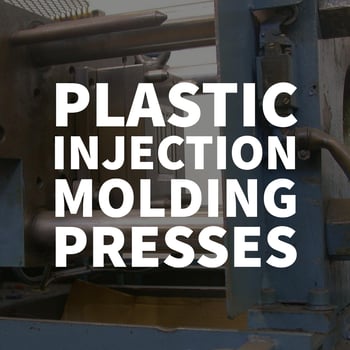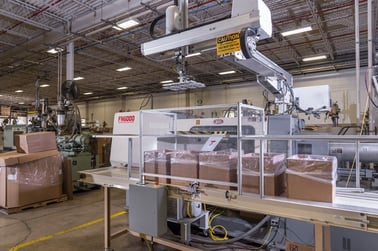Injection molding presses allow manufacturers to produce a wide range of quality custom parts from high-performance resins. Depending on the press size and type, these advanced machines offer many different performance options and capabilities. To ensure the highest level of quality and value, it’s important to work with a manufacturer that can offer the proper size injection molding press for your particular needs. Here, we’ll go over the key components of an injection molding press to keep in mind when determining the right size machinery for your project.
What Is a Press In Injection Molding?
In plastic injection molding, melted plastic resin is heated and injected into a mold at extremely high pressures. The melted plastic cools and hardens into the shape of the mold, which then opens to allow the part to be ejected for inspection, secondary processes, or delivery.
The injection molding press is specifically designed to keep the mold shut throughout the molding operation, with larger parts requiring more force and tonnage, and smaller components requiring less. The press consists of various parts that work together to produce a finished product. These parts include:
- Hopper.The hopper is responsible for feeding plastic resin shavings, flakes, or pellets into the machine.
- Barrel. The barrel consists of heater bands and an injection molding screw. Once the resin enters the barrel’s chamber, the heater bands melt the plastic before it is injected into the mold by the screw.
- Platens. The platens are typically made of steel and are used to hold both halves of the mold.
- Clamp. The clamp is used to open and close the mold.
 To ensure optimal quality and value, it’s critical to partner with a manufacturer who can provide the right size press for your specific needs.
To ensure optimal quality and value, it’s critical to partner with a manufacturer who can provide the right size press for your specific needs.
How Are Plastic Injection Molding Presses Rated?
An experienced plastic injection molder can help you select the correctly sized machine for your project, and will be able to provide you with an accurate size estimate right from the start based on a few key pieces of information.
Presses are rated, or classified, based on tonnage, which indicates how much clamping pressure a particular machine can offer. Press tonnage, or force, can range from less than 5 tons to over 4,000 tons. The higher a machine's tonnage is rated, the larger it is.
Many plastic injection molders provide a list of molding equipment used in their facilities on their websites, along with each machines’ tonnage capabilities.
How Do You Calculate Press Tonnage for Injection Molding?
Proper calculation of press tonnage first requires knowing the estimated area of the molded part(s) and any runners. You can calculate area by multiplying length times width: A = πr2 or A = L x W.
Once you’ve calculated the estimated area in square inches, you’ll need to know what material you’re using to produce the molded part. High-flow materials like polypropylene (PP), polyethylene (PE), and polystyrene (PS) require less tonnage to keep the mold closed (about 2-3 tons per square inch), whereas stiffer materials like polysulphone (PSU) and Nylon (PA) require more (about 3-5 tons per square inch). Generally, your material supplier should be able to specify the required tonnage needed to mold a particular material.
Then, you’ll be able to calculate the total necessary tonnage by multiplying the projected area times your material’s clamp factor: T = A x CF. For example, if your molded part has an estimated area of 150 square inches with a clamp factor of 3 tons, your total tonnage needed is 450 (150 x 3 = 450).
How Much Clamping Force Do I Need?
Pressure keeps a mold closed during the injection process; too much or too little can compromise quality and result in flashing — the appearance of excess material on the part edge. To determine the appropriate size press for your application, consider the following key variables:
- Press rating. A machine with a 68-ton rating, for instance, will be able to deliver 68 tons of clamping pressure, or force.
- Material choice and MFI.The melt flow index (MFI) of plastic, or melt flow rate (MFR), indicates the ease of flow of a molten plastic material. A high MFI will require more pressure than a low MFI.
- Size.The size of the part will naturally affect the size of the machine needed. Many calculations include platen size in addition to mold and part size.
- Safety factor. A numerical percentage incorporated into size calculations to help avoid defects in the final part, the safety factor acts as a buffer; some experts recommend adding 10% to the overall press size estimate.
 For most projects, we recommend calculating the required machine size using 2.5 times the surface square inches of the part and incorporating the 10% safety factor. So for example, a part with 42 square inches would need a press size with 105 tons of pressure. If you add 10% for a safety factor, you will need to use a press with a minimum of 115 tons of clamping force. A press size of 120 tons would be able to accommodate this plastic injection molded product.
For most projects, we recommend calculating the required machine size using 2.5 times the surface square inches of the part and incorporating the 10% safety factor. So for example, a part with 42 square inches would need a press size with 105 tons of pressure. If you add 10% for a safety factor, you will need to use a press with a minimum of 115 tons of clamping force. A press size of 120 tons would be able to accommodate this plastic injection molded product.
Rely on the Rodon Group for Your Plastic Injection Molding Needs
By understanding press ratings, tonnage, and clamping force, you’ll better be able to determine the right size press for your needs. Once you know what size you need, you can begin looking for a manufacturer. At The Rodon Group, we have a 125,000-square-foot manufacturing facility with 117 state-of-the-art plastic injection molding presses. Each of our machines is fully robotic, microprocessor-controlled, and highly automated to ensure optimal precision and quality. We also offer injection molding design and mold building services to meet your exact specifications.
For more information about our capabilities, or for help determining the right size injection molding press for your needs, contact us or request a quote today.









Comments